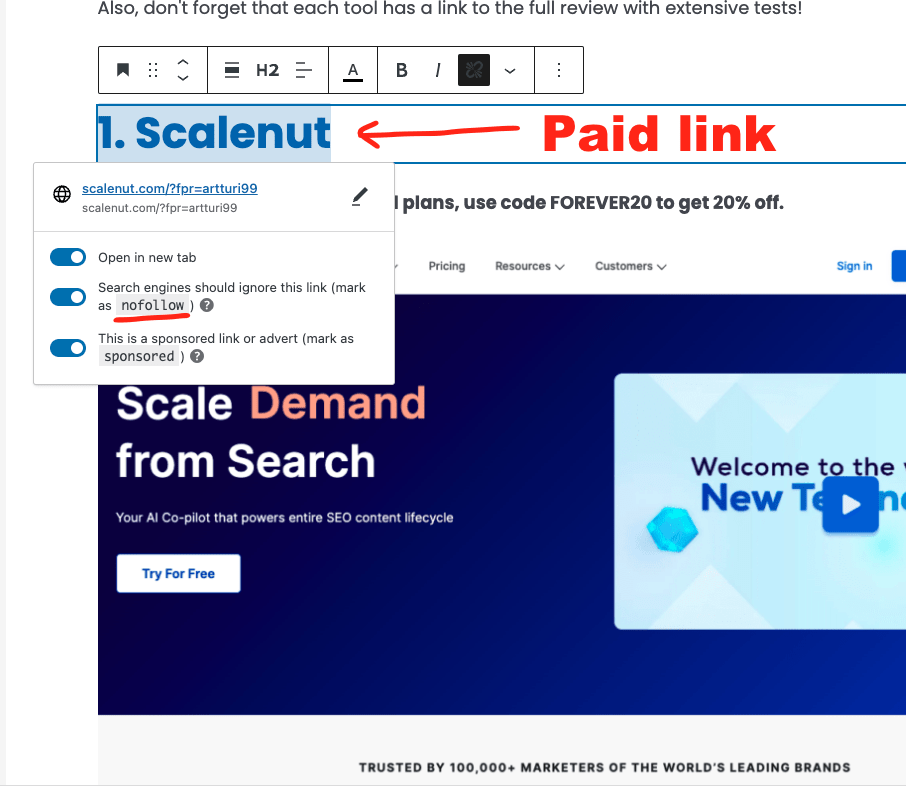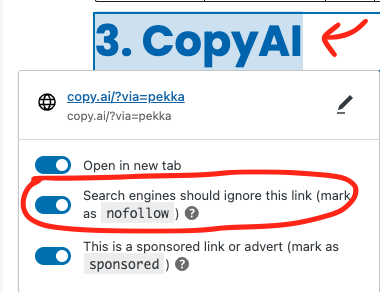A no-follow backlink is a link that is manually marked as paid or sponsored.
A blogger/web author must always manually mark every sponsored, paid, or affiliate link as “no-follow”.

What is a No-Follow Backlink?
Let’s take a look at a more formal definition of a “no-follow” backlink.
A no-follow backlink is a type of backlink that includes a ‘rel=”nofollow”‘ tag in the HTML code.
This attribute tells search engine bots not to follow the link. This is important because search engines want to know what links come naturally and what links are paid for.
When Google encounters a “no-follow” link, it won’t pass any link “link juice” to the target website.
But Why?
Google uses links to determine the “trustworthiness” and “authority” of a website. The more links, the better.
This makes sense. If a resource is worth reading, people will naturally link to it.
Google thus uses links to determine which websites and blog posts it should rank high.
However, this kind of system has a major flaw. One can pay/build links to trick Google. To fight this, Google wants websites to mark all “inorganically built” links as “no-follow”.
In simpler terms, a “no-follow” link is a way to link to another site without boosting its rankings.
Example of a “No-follow” Link
Here is an example of what a no-follow link looks like in HTML code (if you don’t know HTML, just skip to the next section):
<a href="http://www.example.com/" rel="nofollow">Link Text</a>
The rel=”nofollow” is the key here.
hen Google bots crawl a website, they inspect links. If they see “nofollow” as the rel attribute, they will ignore those links.
On a web page, a no-follow link looks just like a normal link. The visitor has no clue if it’s a no-follow link or not.

No-Follow vs Do-Follow
In contrast to no-follow links, do-follow links are standard hyperlinks without the ‘rel=”nofollow”‘ attribute.
They pass on link equity to the linked website, helping to boost its rankings on search engines.
Here’s how a do-follow link looks:
<a href="http://www.example.com/">Link Text</a>
Do-follow links also look exactly like no-follow links when seen on a webpage.

🤔 Any link you ever click on any webpage is either a “do-follow” link or a “no-follow” link.
So the difference between no-follow and do-follow links is the way they interact with search engine algorithms.
- Do-follow links improve a page’s importance in the eyes of search engines.
- No-follow links tell search engines to ignore the link in terms of rankings.
When to Use No-Follow Links
As a blogger or website owner, it’s crucial to use no-follow links appropriately to maintain a natural link profile and adhere to search engine guidelines.
Here are some scenarios when you should use no-follow links:
- Paid Links: If you’ve accepted payment to place a link, you should mark it as no-follow. Google’s guidelines state that passing link juice in exchange for money is against their policy.
- Affiliate Links: Like paid links, affiliate links should also be no-follow because you’re receiving compensation for any purchases made through the links.
- Links in Comments and Forums: To protect the website from spam or low-quality links, any link in user-generated content such as blog comments or forum posts should be no-follow.
Make sure to read Why Paid Links Need to Be No-Follow
Failing to use no-follow links appropriately can have consequences.
If search engines perceive that you’re manipulating their algorithms by selling do-follow links or linking to spammy sites, they might penalize your site.
This can lead to a decrease in organic search rankings, a drop in traffic, or de-indexing from the search engine entirely.
How to Mark Links No-Follow?
You don’t need any technical skills to mark links “no-follow”.
For example, if you’re using WordPress:
- Open up the blog post editor.
- Click on a link.
- Check the “no-follow” option.
- Hit “Update” to update the post.

If you’re using other platforms, it’s probably just as easy.
Also, some blogging platforms like Medium.com might automatically mark every link as “no-follow” to avoid issues with Google.
Conclusion
No-follow links are a way to tell Google that a link is sponsored.
If you get paid (directly or indirectly) for placing a link on your site, you should always mark it “no-follow”.
Happy writing!
